

Inheritance tax receipts (IHT) are back on the rise after a downward trajectory over the past three months, according to official data.
HM Revenue and Customs statistics released today (August 21) showed that in July 2019 IHT receipts accounted for £438m, representing an increase of 23 per cent compared with the £357m raised in June but down 6 per cent compared with the same month last year.
This was after IHT bills suffered a downward trajectory from April and means the government's tax take is back on the rise after reaching a peak of £527m in March.
In the financial year 2018/19, a record £5.4bn was paid in tax revenue, with the average IHT bill reaching almost £200,000.
Receipts for April to July 2019 were 12.7 per cent lower than in the same period last year, although according to HMRC IHT receipts for May and June last year were unusually high due to an increase in the number and value of payments.
HMRC also said that March 2019 was particularly high though it was too early to determine the cause for this.
Gordon Andrews, tax and financial planning expert at Quilter, said: “Month by month fluctuations in inheritance tax receipts are not unusual.
“This year we’ve seen some more drastic shifts, which HMRC are pitting down to a number of factors including an increase in the number of payments and the value of those payments.”
HMRC had blamed the introduction of the nil rate band for a sharp fall in receipts in 2007/08.
The nil rate band, also known as the IHT threshold, is the amount up to which an estate has no IHT to pay. The NRB for 2019/20 is £325,000 and any estate which exceeds this threshold is charged 40 per cent in IHT.
Unused NRB and residence nil rate band can be transferred to a surviving spouse or civil partner.
The RNRB came into effect in 2017 and is an additional threshold available where the deceased left a residence, or the sale proceeds of a residence, to their direct descendants. The RNRB for 2019/20 is £150,000, an increase of £25,000 from 2018/19.
Mr Andrews said: “We are still waiting to see the full impact of the main residence nil rate band, which was promised to halt the drastically rising IHT haul the government was receiving.
“However, the RNRB is immensely complicated, to the extent that some solicitors are refusing to advise on estates on the RNRB.”
Last month (July 22), a Freedom of Information request by Quilter to the tax authority revealed that more than 5,000 IHT investigations are opened by HMRC each year, representing about a quarter of estates that pay IHT.
According to the FOI, 5,537 investigations were carried out in the last tax year, down 9 per cent on the 6,088 peak in 2013/14 but up 6 per cent on 2015/16.
IHT is immensely complicated but a review of IHT rules has already been carried out in order to simplify the system.
The first report from the Office of Tax Simplification (OTS), out last November, recommended the government should move to a fully digital system for IHT.
A final report, published last month (July 5), proposed a change to the ‘seven-year rule’ of taxing gifts alongside changes to the taper relief and others.
Mr Andrews said: “The complications around IHT make it ripe for financial advisers to make a difference and saving for their clients.
“However, the depth of that complication is unsustainable and so it is vital the government take the OTS’'s recommendations seriously.”
amy.austin@ft.com
What do you think about the issues raised by this story? Email us on fa.letters@ft.com to let us know.



